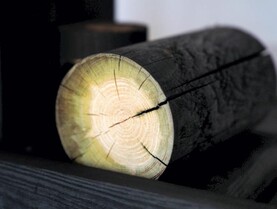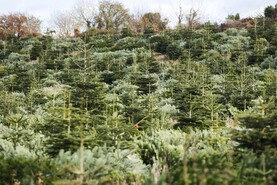Last Thursday’s national forestry conference addressed the existing and potential threats of insect pests and diseases to Irish forests. Opened by Pippa Hackett, Minister of State with responsibility for forestry, she outlined her views on tree health to the webinar conference as 218 attendees logged in.
Referring to International Year of Plant Health 2020, she said: “While it is important that we concentrate on protecting Ireland from threats of introduced new pests, we also need to link with European and international processes and initiatives.”
Minister’s views
In her conference interview and programme foreword, Minister Hackett acknowledged the need for increased felling licences to reduce the reliance on imported timber from areas that have harmful insect pests. She discussed the importance of the Forestry (Miscellaneous Provisions) Act, which has been enacted.
This, she maintained, would allow increased resources to the Forestry Appeals Committee (FAC) to speed up appeals, as well as addressing the backlog in processing afforestation and felling licences.
Organised by the Wood Marketing Federation and the Society of Irish Foresters, and facilitated by the Irish Bioenergy Association, the conference theme – ‘Protecting our Trees and Forests’ – was addressed by a sawmiller, forester, plant pathologist, forest health inspector and two researchers.
Known and unknown pests
Dr Richard O’Hanlon, Agri-Food and Biosciences Institute, Northern Ireland said: “The island of Ireland has many advantages in terms of protection against non-native pests and pathogens.”
But he acknowledged that tree health is under an ever increasing threat, citing non-native Dutch elm disease, sudden larch death and ash dieback.
“Recent research indicates that there are over 390 pests of trees and woody plants in Ireland and Northern Ireland, with more than 40 being suspected as introductions.”
Some positive developments have recently occurred
He outlined key challenges to preventing new disease outbreaks, including dealing with unknown pests, legislating for new pests and early detection of new pests. A common theme during the conference was the need for research into pests and their interaction with climate.
“Some positive developments have recently occurred, in terms of global horizon scanning initiatives and technological advances,” he said.
“These developments, if combined with efforts to increase forest resilience, can act to safeguard forests from future disease epidemics.”
The Department also oversees the national production of ISPM 15 compliant WPM to facilitate Irish exports
Plant health
Conscious of recent increased imports, Tom McDonald, inspector of forest health, Forest Service, said the Department conducts import controls for a range of controlled wood and wood products, including Wood Packaging Material (WPM), to prevent the potential import of harmful organisms.
Regarding Brexit he said: “The Department also oversees the national production of ISPM 15 compliant WPM to facilitate Irish exports and has been working closely with the sector on the new plant health requirements for traders with the UK, following its departure from the EU at the end of the transition period.”
The sawmiller’s view
Brian Murphy, CEO Balcas and chairman Forest Industries Ireland, said his experience of pests and disease is one of dealing with the consequences.
“For example, we were able to assist the NI Forest Service with the consequences of Phytophthora ramorum, “ he said.
“Disease infested larch was identified, felled and segregated, with logs transported on pre-approved road corridors to our factory in Enniskillen, where they were isolated in a quarantine area on our site.”
Murphy opted for a positive, upbeat presentation, emphasising the need to continue to develop a strong industry
He outlined the debarking and processing operation, as well as the cleansing of lorries and debarkers.
Despite the negativity surrounding the licence issue, Murphy opted for a positive, upbeat presentation, emphasising the need to continue to develop a strong industry to include “the ingredient of value and wealth creation”. This, he said, will “give us the wherewithal and motivations to protect our forests”.
The grower’s view
Mechteld Schuller, executive secretary of the Irish Timber Growers Association (ITGA), emphasised the need to implement the Department’s Plant Health and Biosecurity Strategy in a paper titled As the grower sees it. She said ITGA has called for an Implementation Plan as well as an Emergency Response Plan “to immediately respond to any newly discovered pests and diseases”.
Schuller called for clear guidance on biosecurity for those working in forestry “to minimise the risk of introducing or spreading pests and diseases”.
She also discussed pest control and why it should be integrated in forest management planning.
“As part of the European Green Deal, there will be a requirement to reduce the use of pesticides by 50% and systems such as those employed in forest certification could assist in addressing this requirement.”
Risk analysis
Dr Melanie Tuffen, plant health science advisor with the Department for Environment, Food and Rural Affairs in the UK, presented a paper on pest risk analysis in protecting commercial forests.
“As an island, pests and diseases have little opportunity to arrive via natural spread, and most introductions will occur in association with imported commodities such as plants for planting, timber, wood packaging material and seeds,” she told the conference.
“One action was placing phytosanitary measures or conditions on the trade of these goods, such as requiring specific treatments like kiln drying to help reduce the risk of pests being associated with a commodity.”
The first rapid PRA scheme for Ireland has been developed
She outlined her views on Pest Risk Analysis (PRA), which can be carried out on both pests and pathways.
“The first rapid PRA scheme for Ireland has been developed,” she said.
She stressed the importance of Protected Zones to Ireland. These zones are a form of EU legislation that allows a member state to place additional phytosanitary measures on commodities, to reduce the risk of pests entering countries free of these risks, which is vital to Irish forest health.
Fortunately, Ireland has more Protected Zones than any other EU member state.
Ash dieback
Ash dieback, which generated a high degree of comments and feedback, was addressed by Dr Miguel Nemesio-Gorriz, research officer with Teagasc. He is currently working on the identification and propagation of ash genotypes tolerant to ash dieback disease.
“A breeding programme for tolerance to ash dieback has been started and several key research lines are being pursued,” he said.
Breeding for resistance to ash dieback offers a chance for a new start
“These include the development of markers for tolerance to ash dieback, the study of alternative infection pathways for the pathogen causing dieback, the adaptation of native ash to current climates and silvicultural alternatives to mitigate the impact of the disease.
“Breeding for resistance to ash dieback offers a chance for a new start with ‘optimally adapted material’.”
RUS
During the panel discussion, farmers and foresters who are managing infected ash forests expressed dissatisfaction with the Reconstitution and Underplanting Scheme (RUS). Forestry companies and owners said they have received no RUS approvals to-date.
A Green Belt spokesperson said: “We have 43 RUS applications lodged with the Department, without even a formal acknowledgement, let alone approvals.”
When asked during the opening of the conference if she would revisit the RUS, Minister Hackett said: “If ash owners wish to engage with me on ash dieback, I am willing to listen and learn about their concerns.”






 This is a subscriber-only article
This is a subscriber-only article









SHARING OPTIONS: